light NISSAN KICKS 2019 Owner´s Manual
[x] Cancel search | Manufacturer: NISSAN, Model Year: 2019, Model line: KICKS, Model: NISSAN KICKS 2019Pages: 444, PDF Size: 5.55 MB
Page 389 of 444
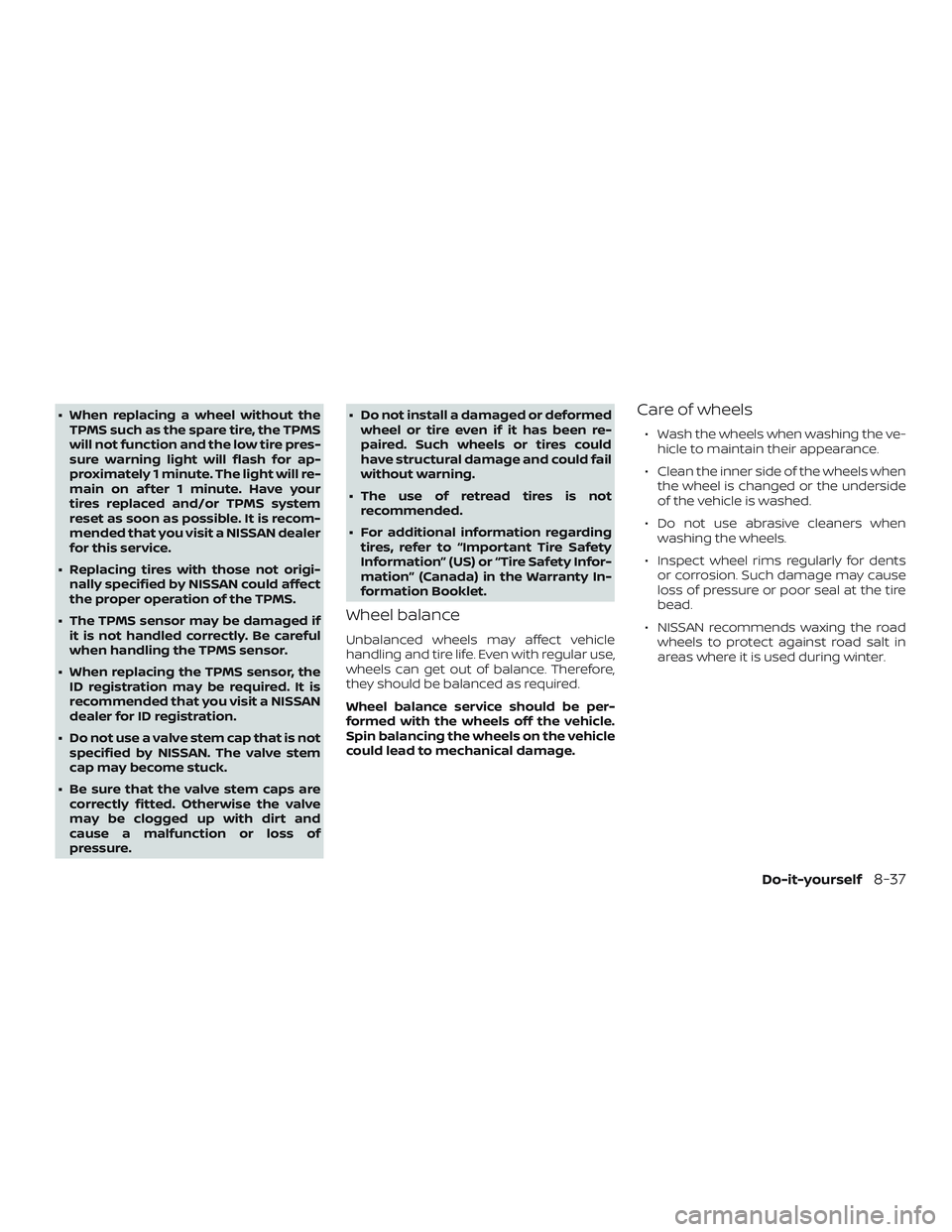
∙ When replacing a wheel without theTPMS such as the spare tire, the TPMS
will not function and the low tire pres-
sure warning light will flash for ap-
proximately 1 minute. The light will re-
main on af ter 1 minute. Have your
tires replaced and/or TPMS system
reset as soon as possible. It is recom-
mended that you visit a NISSAN dealer
for this service.
∙ Replacing tires with those not origi- nally specified by NISSAN could affect
the proper operation of the TPMS.
∙ The TPMS sensor may be damaged if it is not handled correctly. Be careful
when handling the TPMS sensor.
∙ When replacing the TPMS sensor, the ID registration may be required. It is
recommended that you visit a NISSAN
dealer for ID registration.
∙ Do not use a valve stem cap that is not specified by NISSAN. The valve stem
cap may become stuck.
∙ Be sure that the valve stem caps are correctly fitted. Otherwise the valve
may be clogged up with dirt and
cause a malfunction or loss of
pressure. ∙ Do not install a damaged or deformed
wheel or tire even if it has been re-
paired. Such wheels or tires could
have structural damage and could fail
without warning.
∙ The use of retread tires is not recommended.
∙ For additional information regarding tires, refer to “Important Tire Safety
Information” (US) or “Tire Safety Infor-
mation” (Canada) in the Warranty In-
formation Booklet.
Wheel balance
Unbalanced wheels may affect vehicle
handling and tire life. Even with regular use,
wheels can get out of balance. Therefore,
they should be balanced as required.
Wheel balance service should be per-
formed with the wheels off the vehicle.
Spin balancing the wheels on the vehicle
could lead to mechanical damage.
Care of wheels
∙ Wash the wheels when washing the ve- hicle to maintain their appearance.
∙ Clean the inner side of the wheels when the wheel is changed or the underside
of the vehicle is washed.
∙ Do not use abrasive cleaners when washing the wheels.
∙ Inspect wheel rims regularly for dents or corrosion. Such damage may cause
loss of pressure or poor seal at the tire
bead.
∙ NISSAN recommends waxing the road wheels to protect against road salt in
areas where it is used during winter.
Do-it-yourself8-37
Page 393 of 444
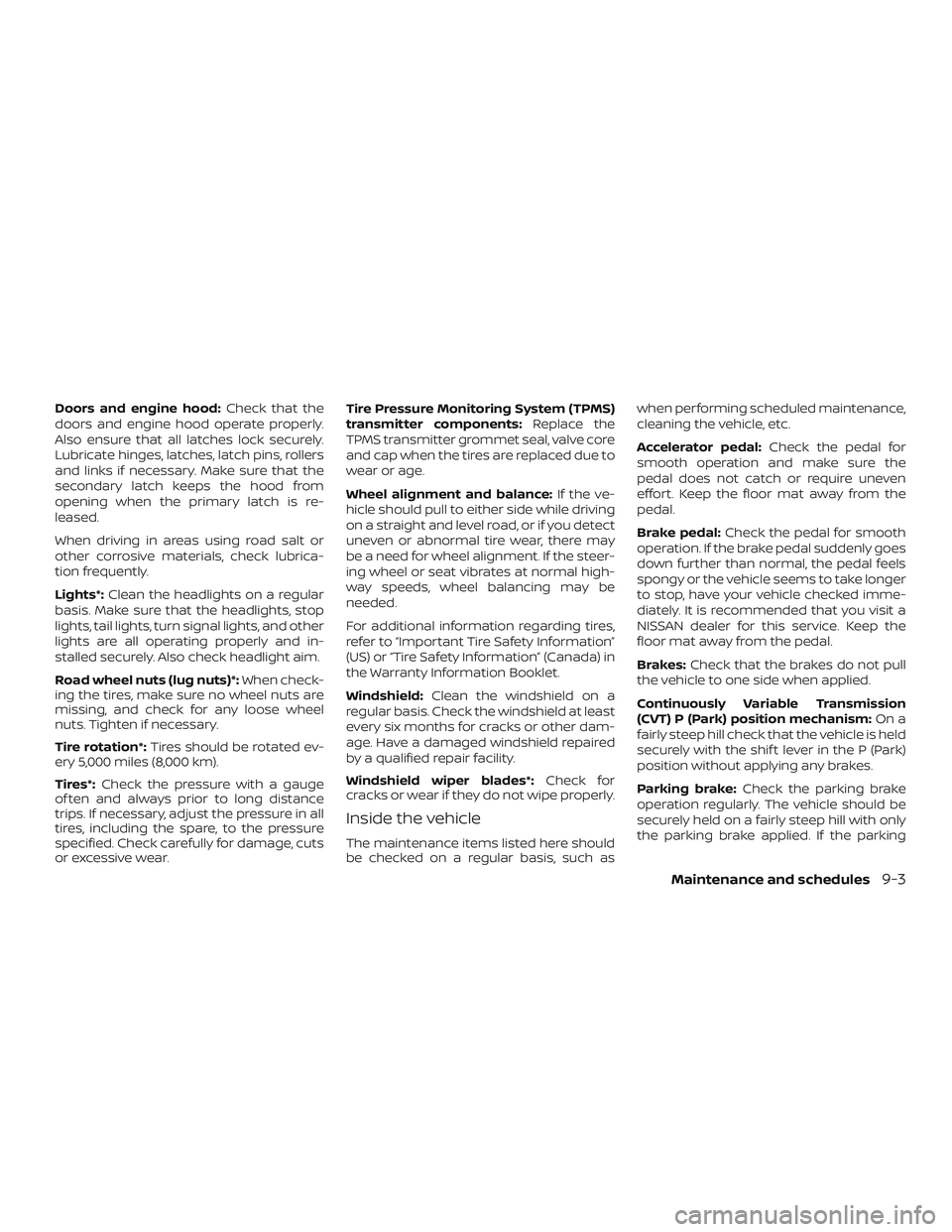
Doors and engine hood:Check that the
doors and engine hood operate properly.
Also ensure that all latches lock securely.
Lubricate hinges, latches, latch pins, rollers
and links if necessary. Make sure that the
secondary latch keeps the hood from
opening when the primary latch is re-
leased.
When driving in areas using road salt or
other corrosive materials, check lubrica-
tion frequently.
Lights*: Clean the headlights on a regular
basis. Make sure that the headlights, stop
lights, tail lights, turn signal lights, and other
lights are all operating properly and in-
stalled securely. Also check headlight aim.
Road wheel nuts (lug nuts)*: When check-
ing the tires, make sure no wheel nuts are
missing, and check for any loose wheel
nuts. Tighten if necessary.
Tire rotation*: Tires should be rotated ev-
ery 5,000 miles (8,000 km).
Tires*: Check the pressure with a gauge
of ten and always prior to long distance
trips. If necessary, adjust the pressure in all
tires, including the spare, to the pressure
specified. Check carefully for damage, cuts
or excessive wear. Tire Pressure Monitoring System (TPMS)
transmitter components:
Replace the
TPMS transmitter grommet seal, valve core
and cap when the tires are replaced due to
wear or age.
Wheel alignment and balance: If the ve-
hicle should pull to either side while driving
on a straight and level road, or if you detect
uneven or abnormal tire wear, there may
be a need for wheel alignment. If the steer-
ing wheel or seat vibrates at normal high-
way speeds, wheel balancing may be
needed.
For additional information regarding tires,
refer to “Important Tire Safety Information”
(US) or “Tire Safety Information” (Canada) in
the Warranty Information Booklet.
Windshield: Clean the windshield on a
regular basis. Check the windshield at least
every six months for cracks or other dam-
age. Have a damaged windshield repaired
by a qualified repair facility.
Windshield wiper blades*: Check for
cracks or wear if they do not wipe properly.
Inside the vehicle
The maintenance items listed here should
be checked on a regular basis, such as when performing scheduled maintenance,
cleaning the vehicle, etc.
Accelerator pedal:
Check the pedal for
smooth operation and make sure the
pedal does not catch or require uneven
effort. Keep the floor mat away from the
pedal.
Brake pedal: Check the pedal for smooth
operation. If the brake pedal suddenly goes
down further than normal, the pedal feels
spongy or the vehicle seems to take longer
to stop, have your vehicle checked imme-
diately. It is recommended that you visit a
NISSAN dealer for this service. Keep the
floor mat away from the pedal.
Brakes: Check that the brakes do not pull
the vehicle to one side when applied.
Continuously Variable Transmission
(CVT) P (Park) position mechanism: On a
fairly steep hill check that the vehicle is held
securely with the shif t lever in the P (Park)
position without applying any brakes.
Parking brake: Check the parking brake
operation regularly. The vehicle should be
securely held on a fairly steep hill with only
the parking brake applied. If the parking
Maintenance and schedules9-3
Page 394 of 444
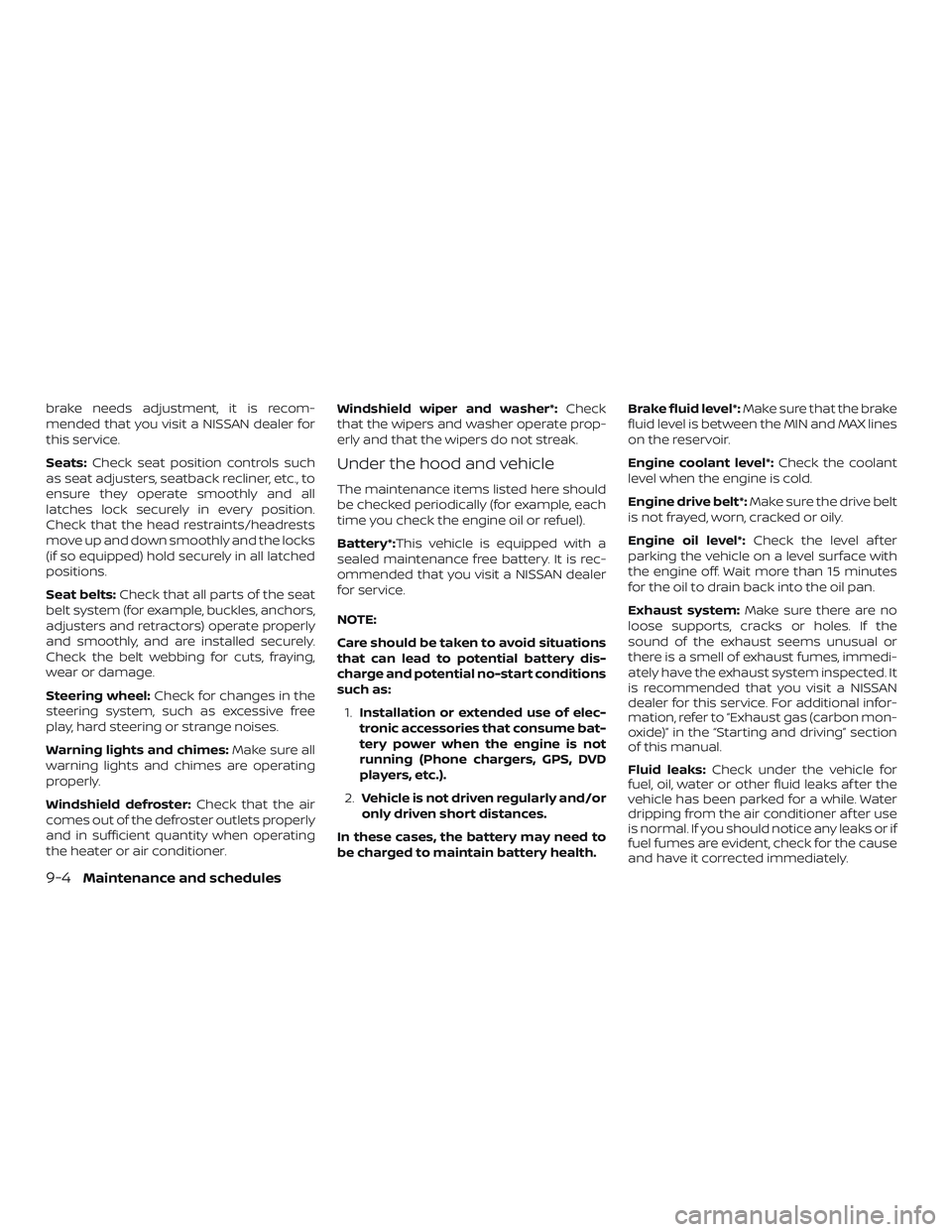
brake needs adjustment, it is recom-
mended that you visit a NISSAN dealer for
this service.
Seats:Check seat position controls such
as seat adjusters, seatback recliner, etc., to
ensure they operate smoothly and all
latches lock securely in every position.
Check that the head restraints/headrests
move up and down smoothly and the locks
(if so equipped) hold securely in all latched
positions.
Seat belts: Check that all parts of the seat
belt system (for example, buckles, anchors,
adjusters and retractors) operate properly
and smoothly, and are installed securely.
Check the belt webbing for cuts, fraying,
wear or damage.
Steering wheel: Check for changes in the
steering system, such as excessive free
play, hard steering or strange noises.
Warning lights and chimes: Make sure all
warning lights and chimes are operating
properly.
Windshield defroster: Check that the air
comes out of the defroster outlets properly
and in sufficient quantity when operating
the heater or air conditioner. Windshield wiper and washer*:
Check
that the wipers and washer operate prop-
erly and that the wipers do not streak.
Under the hood and vehicle
The maintenance items listed here should
be checked periodically (for example, each
time you check the engine oil or refuel).
Battery*:This vehicle is equipped with a
sealed maintenance free battery. It is rec-
ommended that you visit a NISSAN dealer
for service.
NOTE:
Care should be taken to avoid situations
that can lead to potential battery dis-
charge and potential no-start conditions
such as:
1. Installation or extended use of elec-
tronic accessories that consume bat-
tery power when the engine is not
running (Phone chargers, GPS, DVD
players, etc.).
2. Vehicle is not driven regularly and/or
only driven short distances.
In these cases, the battery may need to
be charged to maintain battery health. Brake fluid level*:
Make sure that the brake
fluid level is between the MIN and MAX lines
on the reservoir.
Engine coolant level*: Check the coolant
level when the engine is cold.
Engine drive belt*: Make sure the drive belt
is not frayed, worn, cracked or oily.
Engine oil level*: Check the level af ter
parking the vehicle on a level surface with
the engine off. Wait more than 15 minutes
for the oil to drain back into the oil pan.
Exhaust system: Make sure there are no
loose supports, cracks or holes. If the
sound of the exhaust seems unusual or
there is a smell of exhaust fumes, immedi-
ately have the exhaust system inspected. It
is recommended that you visit a NISSAN
dealer for this service. For additional infor-
mation, refer to “Exhaust gas (carbon mon-
oxide)” in the “Starting and driving” section
of this manual.
Fluid leaks: Check under the vehicle for
fuel, oil, water or other fluid leaks af ter the
vehicle has been parked for a while. Water
dripping from the air conditioner af ter use
is normal. If you should notice any leaks or if
fuel fumes are evident, check for the cause
and have it corrected immediately.
9-4Maintenance and schedules
Page 411 of 444
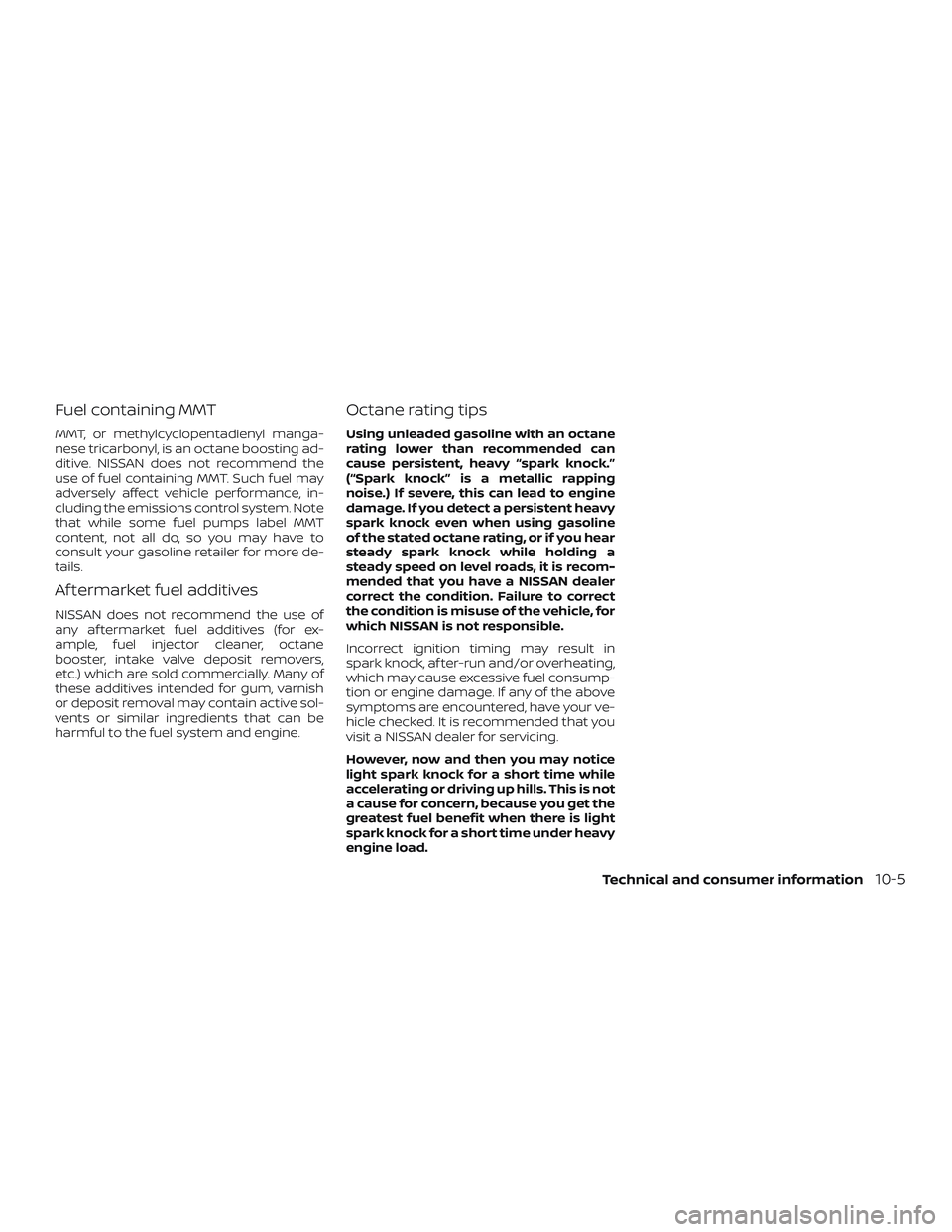
Fuel containing MMT
MMT, or methylcyclopentadienyl manga-
nese tricarbonyl, is an octane boosting ad-
ditive. NISSAN does not recommend the
use of fuel containing MMT. Such fuel may
adversely affect vehicle performance, in-
cluding the emissions control system. Note
that while some fuel pumps label MMT
content, not all do, so you may have to
consult your gasoline retailer for more de-
tails.
Af termarket fuel additives
NISSAN does not recommend the use of
any af termarket fuel additives (for ex-
ample, fuel injector cleaner, octane
booster, intake valve deposit removers,
etc.) which are sold commercially. Many of
these additives intended for gum, varnish
or deposit removal may contain active sol-
vents or similar ingredients that can be
harmful to the fuel system and engine.
Octane rating tips
Using unleaded gasoline with an octane
rating lower than recommended can
cause persistent, heavy “spark knock.”
(“Spark knock” is a metallic rapping
noise.) If severe, this can lead to engine
damage. If you detect a persistent heavy
spark knock even when using gasoline
of the stated octane rating, or if you hear
steady spark knock while holding a
steady speed on level roads, it is recom-
mended that you have a NISSAN dealer
correct the condition. Failure to correct
the condition is misuse of the vehicle, for
which NISSAN is not responsible.
Incorrect ignition timing may result in
spark knock, af ter-run and/or overheating,
which may cause excessive fuel consump-
tion or engine damage. If any of the above
symptoms are encountered, have your ve-
hicle checked. It is recommended that you
visit a NISSAN dealer for servicing.
However, now and then you may notice
light spark knock for a short time while
accelerating or driving up hills. This is not
a cause for concern, because you get the
greatest fuel benefit when there is light
spark knock for a short time under heavy
engine load.
Technical and consumer information10-5
Page 426 of 444
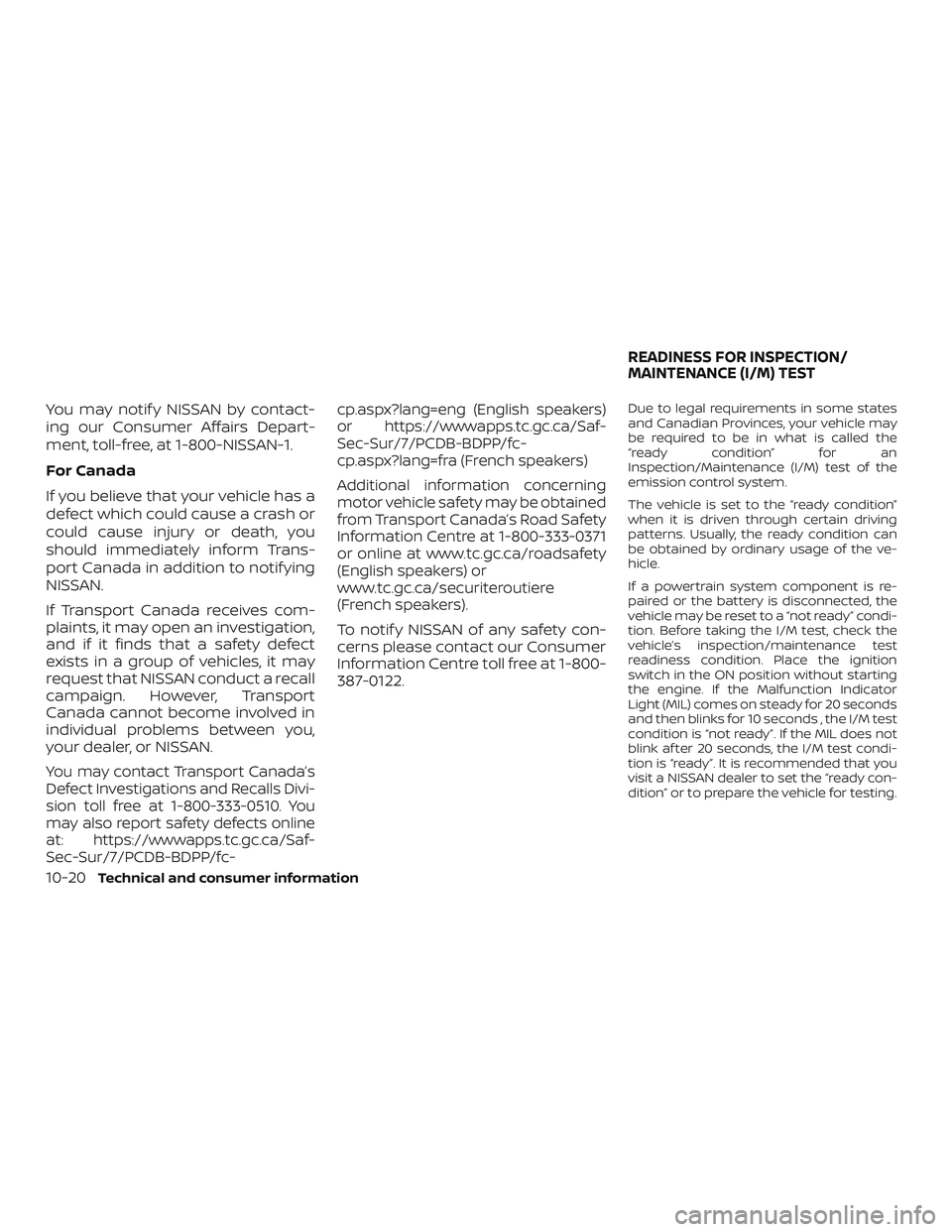
You may notif y NISSAN by contact-
ing our Consumer Affairs Depart-
ment, toll-free, at 1-800-NISSAN-1.
For Canada
If you believe that your vehicle has a
defect which could cause a crash or
could cause injury or death, you
should immediately inform Trans-
port Canada in addition to notif ying
NISSAN.
If Transport Canada receives com-
plaints, it may open an investigation,
and if it finds that a safety defect
exists in a group of vehicles, it may
request that NISSAN conduct a recall
campaign. However, Transport
Canada cannot become involved in
individual problems between you,
your dealer, or NISSAN.
You may contact Transport Canada’s
Defect Investigations and Recalls Divi-
sion toll free at 1-800-333-0510. You
may also report safety defects online
at: https://wwwapps.tc.gc.ca/Saf-
Sec-Sur/7/PCDB-BDPP/fc-cp.aspx?lang=eng (English speakers)
or https://wwwapps.tc.gc.ca/Saf-
Sec-Sur/7/PCDB-BDPP/fc-
cp.aspx?lang=fra (French speakers)
Additional information concerning
motor vehicle safety may be obtained
from Transport Canada’s Road Safety
Information Centre at 1-800-333-0371
or online at www.tc.gc.ca/roadsafety
(English speakers) or
www.tc.gc.ca/securiteroutiere
(French speakers).
To notif y NISSAN of any safety con-
cerns please contact our Consumer
Information Centre toll free at 1-800-
387-0122.
Due to legal requirements in some states
and Canadian Provinces, your vehicle may
be required to be in what is called the
“ready condition” for an
Inspection/Maintenance (I/M) test of the
emission control system.
The vehicle is set to the “ready condition”
when it is driven through certain driving
patterns. Usually, the ready condition can
be obtained by ordinary usage of the ve-
hicle.
If a powertrain system component is re-
paired or the battery is disconnected, the
vehicle may be reset to a “not ready” condi-
tion. Before taking the I/M test, check the
vehicle’s inspection/maintenance test
readiness condition. Place the ignition
switch in the ON position without starting
the engine. If the Malfunction Indicator
Light (MIL) comes on steady for 20 seconds
and then blinks for 10 seconds , the I/M test
condition is “not ready”. If the MIL does not
blink af ter 20 seconds, the I/M test condi-
tion is “ready”. It is recommended that you
visit a NISSAN dealer to set the “ready con-
dition” or to prepare the vehicle for testing.
READINESS FOR INSPECTION/
MAINTENANCE (I/M) TEST
10-20Technical and consumer information
Page 429 of 444
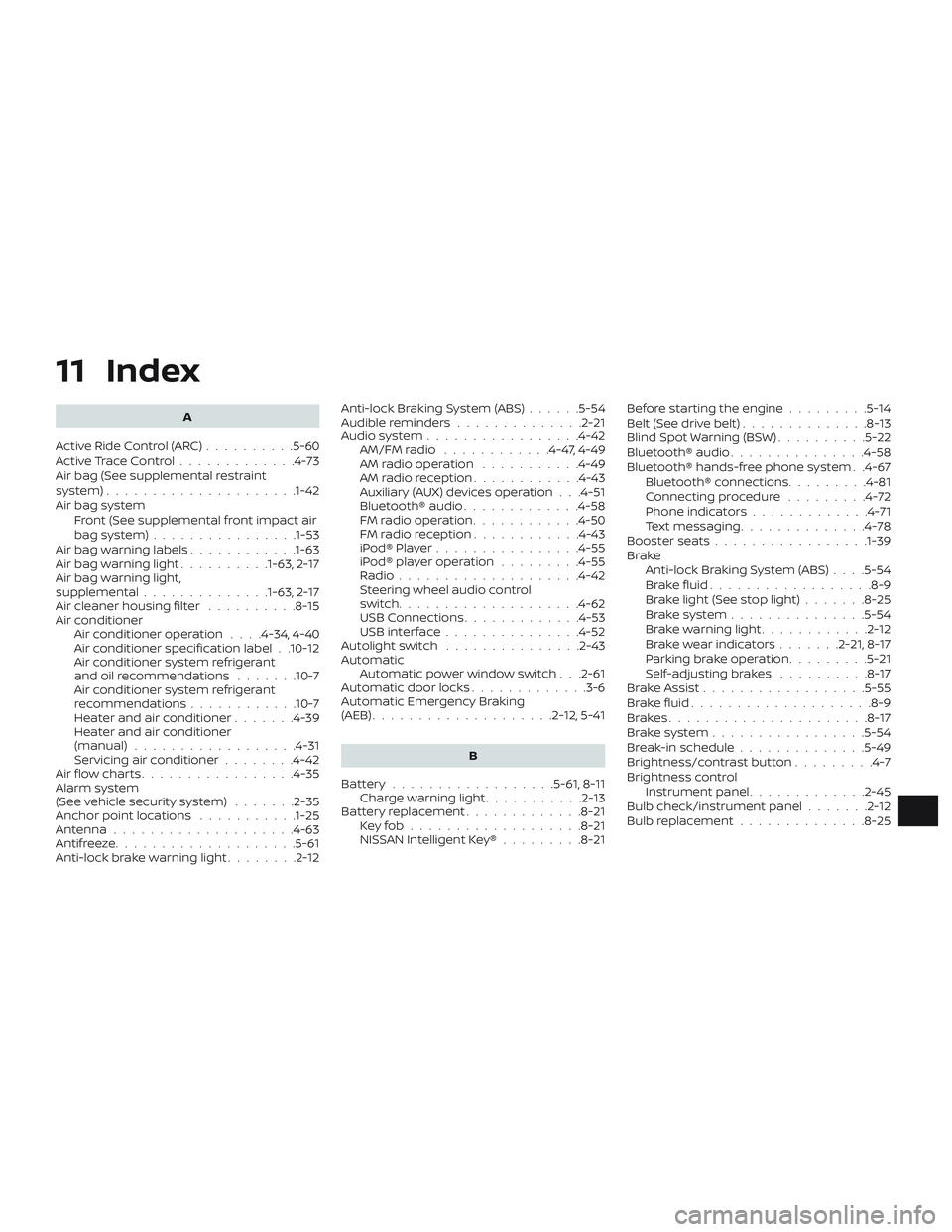
11 Index
A
ActiveRideControl(ARC)..........5-60
ActiveTraceControl.............4-73
Air bag (See supplemental restraint
system) .................... .1-42
Air bag system Front (See supplemental front impact air
bagsystem)............... .1-53
Air bag warning labels ............1-63
Airbagwarninglight..........1-63, 2-17
Air bag warning light,
supplemental ..............1-63, 2-17
Air cleaner housing filter ..........8-15
Air conditioner Air conditioner operation ....4-34,4-40
Air conditioner specification label . .10-12
Air conditioner system refrigerant
and oil recommendations .......10-7
Air conditioner system refrigerant
recommendations ............10-7
Heater and air conditioner .......4-39
Heater and air conditioner
(manual) ..................4-31
Servicing air conditioner ........4-42
Air flow charts .................4-35
Alarm system
(See vehicle security system) .......2-35
Anchor point locations ...........1-25
Antenna ....................4-63
Antifreeze ....................5-61
Anti-lock brake warning light ........2-12Anti-lock Braking System (ABS)
......5-54
Audible reminders ..............2-21
Audiosystem.................4-42 AM/FMradio ............4-47,4-49
AM radio operation ...........4-49
AMradioreception............4-43
Auxiliary (AUX) devices operation . . .4-51
Bluetooth® audio .............4-58
FM radio operation ............4-50
FMradioreception............4-43
iPod®Player................4-55
iPod® player operation .........4-55
Radio ....................4-42
Steering wheel audio control
switch....................4-62
USB Connections .............4-53
USBinterface...............4-52
Autolightswitch ...............2-43
Automatic Automatic power window switch . . .2-61
Automatic door locks .............3-6
Automatic Emergency Braking
(AEB) ....................2-12,5-41
B
Battery..................5-61,8-11 Charge warning light ...........2-13
Battery replacement .............8-21
Keyfob...................8-21
NISSAN Intelligent Key® .........8-21Before starting the engine
.........5-14
Belt(Seedrivebelt)..............8-13
Blind Spot Warning (BSW) ..........5-22
Bluetooth® audio ...............4-58
Bluetooth® hands-free phone system . .4-67 Bluetooth® connections .........4-81
Connecting procedure .........4-72
Phone indicators .............4-71
Text messaging ..............4-78
Booster seats .................1-39
Brake Anti-lock Braking System (ABS) ....5-54
Brakefluid..................8-9
Brakelight(Seestoplight).......8-25
Brakesystem...............5-54
Brakewarninglight............2-12
Brakewearindicators.......2-21,8-17
Parking brake operation .........5-21
Self-adjustingbrakes ..........8-17
Brake Assist ..................5-55
B
rakefluid....................8-9
Brakes......................8-17
Brakesystem.................5-54
Break-in schedule ..............5-49
Brightness/contrast button .........4-7
Brightness control Instrument panel .............2-45
Bulb check/instrument panel .......2-12
Bulb replacement ..............8-25
Page 430 of 444
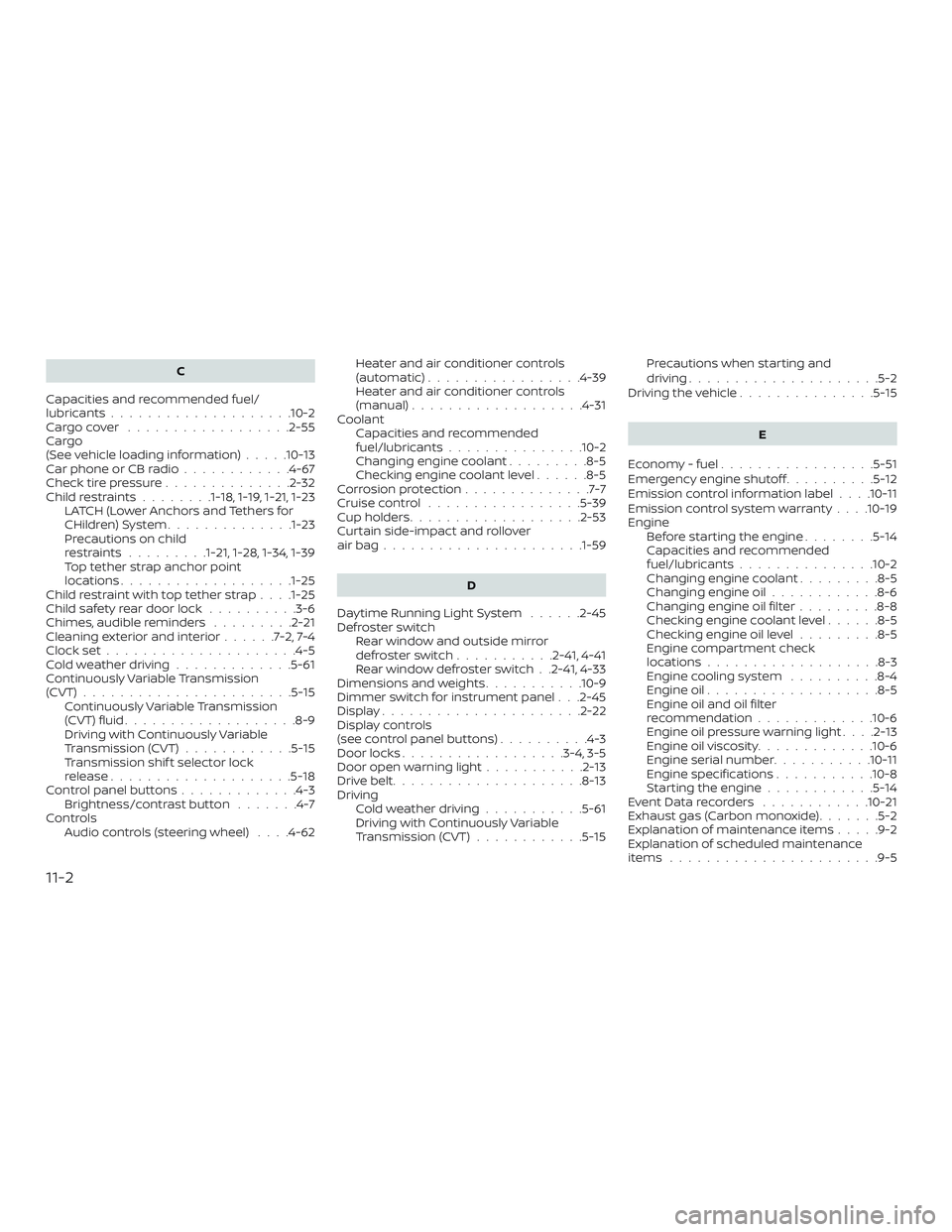
C
Capacities and recommended fuel/
lubricants....................10-2
Cargocover ..................2-55
Cargo
(See vehicle loading information) .....10-13
Car phone or CB radio ............4-67
Check tire pressure ..............2-32
Childrestraints........1-18, 1-19, 1-21, 1-23 LATCH (Lower Anchors and Tethers for
CHildren)System............. .1-23
Precautions on child
restraints.........1-21, 1-28, 1-34, 1-39
Top tether strap anchor point
locations.................. .1-25
Child restraint with top tether strap . . . .1-25
Child safety rear door lock ..........3-6
Chimes, audible reminders .........2-21
Cleaningexteriorandinterior......7-2,7-4
Clockset.....................4-5
Coldweatherdriving.............5-61
Continuously Variable Transmission
(CVT) .......................5-15
Continuously Variable Transmission
(CVT) fluid ...................8-9
Driving with Continuously Variable
Transmission (CVT) ............5-15
Transmission shif t selector lock
release....................5-18
Control panel buttons .............4-3
Brightness/contrast button .......4-7
Controls Audio controls (steering wheel) ....4-62Heater and air conditioner controls
(automatic).................4-39
Heater and air conditioner controls
(manual)
...................4-31
Coolant Capacities and recommended
fuel/lubricants...............10-2
Changing engine coolant .........8-5
Checking engine coolant level ......8-5
Corrosionprotection..............7-7
Cruisecontrol .................5-39
Cupholders...................2-53
Curtain side-impact and rollover
airbag..................... .1-59
D
Daytime Running Light System ......2-45
Defroster switch Rear window and outside mirror
defrosterswitch...........2-41,4-41
Rear window defroster switch . .2-41, 4-33
Dimensions and weights ...........10-9
Dimmer switch for instrument panel . . .2-45
Display......................2-22
Display controls
(see control panel buttons) ..........4-3
Door locks ..................3-4,3-5
Door open warning light ...........2-13
Drivebelt.....................8-13
Driving Cold weather driving ...........5-61
Driving with Continuously Variable
Transmission (CVT) ............5-15 Precautions when starting and
driving
.....................5-2
Driving the vehicle ...............5-15
E
Economy - fuel .................5-51
Emergency engine shutoff ..........5-12
Emission control information label . . . .10-11
Emission control system warranty . . . .10-19
Engine Before starting the engine ........5-14
Capacities and recommended
fuel/lubricants...............10-2
Changing engine coolant .........8-5
Changing engine oil ............8-6
Changing engine oil filter .........8-8
Checking engine coolant level ......8-5
Checking engine oil level .........8-5
Engine compartment check
locations...................8-3
Engine cooling system ..........8-4
Engine oil ...................8-5
Engine oil and oil filter
recommendation .............10-6
Engine oil pressure warning light ....2-13
Engine oil viscosity .............
10-6
Engine serial number ...........10-11
Engine specifications ...........10-8
Starting the engine ............5-14
EventDatarecorders ............10-21
Exhaust gas (Carbon monoxide) .......5-2
Explanation of maintenance items .....9-2
Explanation of scheduled maintenance
items .......................9-5
11-2
Page 431 of 444
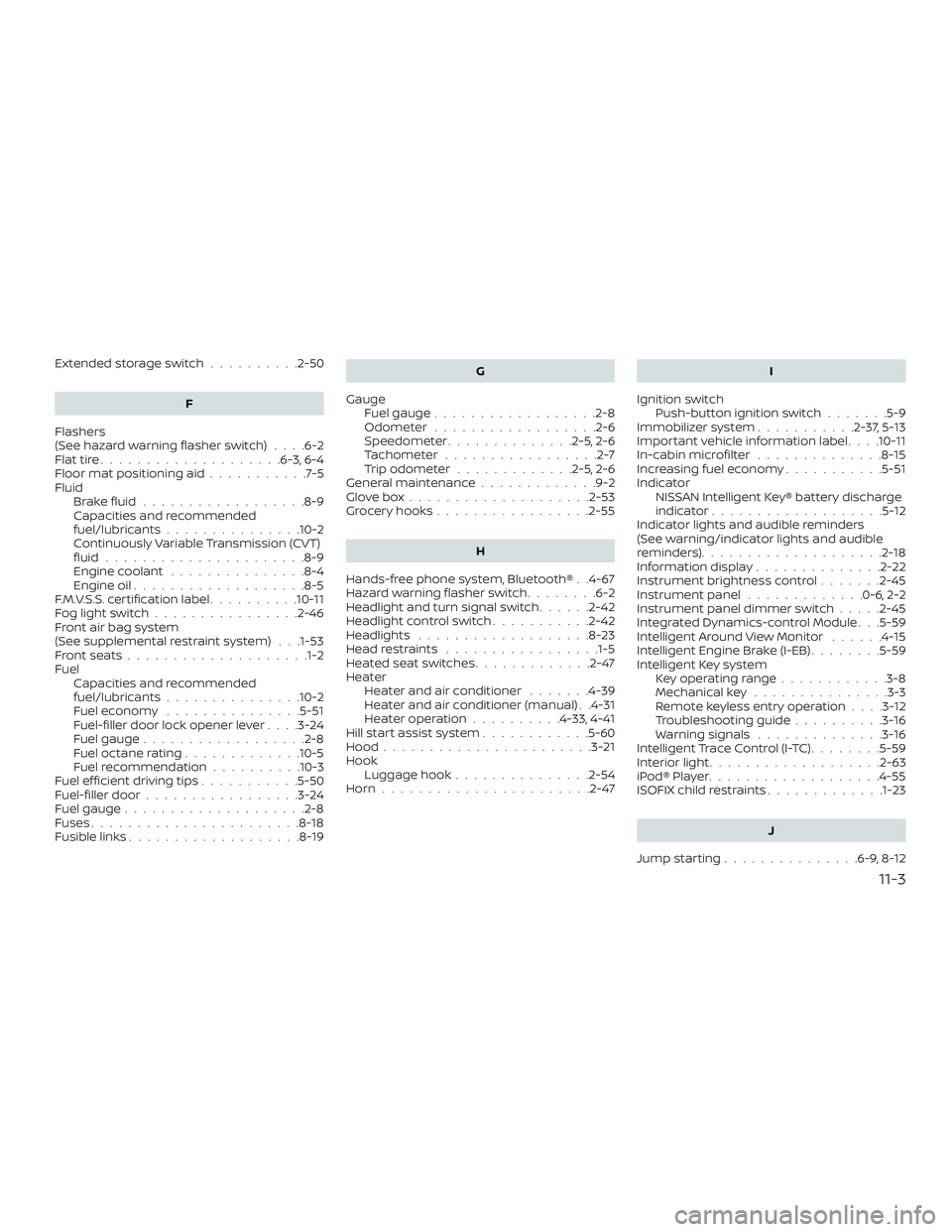
Extended storage switch..........2-50
F
Flashers
(See hazard warning flasher switch) ....6-2
Flattire....................6-3,6-4
Floormatpositioningaid...........7-5
Fluid Brakefluid..................8-9
Capacities and recommended
fuel/lubricants...............10-2
Continuously Variable Transmission (CVT)
fluid......................8-9
Engine coolant ...............8-4
Engine oil ...................8-5
F.M.V.S.S. certification label ..........10-11
Foglightswitch................2-46
Front air bag system
(See supplemental restraint system) . . .1-53
Frontseats................... .1-2
Fuel Capacities and recommended
fuel/lubricants...............10-2
Fuel economy ...............5-51
Fuel-filler door lock opener lever ....3-24
Fuel gauge ..................2-8
Fueloctanerating.............10-5
Fuel recommendation ..........10-3
Fuelefficientdrivingtips...........5-50
Fuel-filler door .................3-24
Fuel gauge ....................2-8
Fuses .......................8-18
Fusiblelinks...................8-19 G
Gauge Fuel gauge ..................2-8
Odometer ..................2-6
Speedometer ..............2-5,2-6
Tachometer .................2-7
Trip odometer .............2-5,2-6
General maintenance .............9-2
Glovebox....................2-53
Grocery hooks .................2-55
H
Hands-free phone system, Bluetooth® . .4-67
Hazard warning flasher switch ........6-2
Headlight and turn signal switch ......2-42
Headlightcontrolswitch...........2-42
Headlights ...................8-23
Headrestraints ................ .1-5
Heated seat switches .............2-47
Heater Heater and air conditioner .......4-39
Heater and air conditioner (manual) . .4-31
Heater operation ..........4-33,4-41
Hill start assist system ............5-60
Hood ...................... .3-21
Hook Luggage hook ...............2-54
Horn.......................2-47 I
Ignition switch Push-button ignition switch .......5-9
Immobilizer system ...........2-37, 5-13
Important vehicle information label . . . .10-11
In-cabinmicrofilter ..............8-15
Increasing fuel economy ...........5-51
Indicator NISSAN Intelligent Key® battery discharge
indicator...................5-12
Indicator lights and audible reminders
(See warning/indicator lights and audible
reminders) ....................2-18
Informationdisplay..............2-22
Instrument brightness control .......2-45
Instrument panel .............0-6,2-2
Instrument panel dimmer switch .....2-45
Integrated Dynamics-control Module . . .5-59
Intelligent Around View Monitor ......4-15
Intelligent Engine Brake (I-EB) ........5-59
Intelligent Key system Key operating range ............3-8
Mechanic
al key...............3-3
Remote keyless entry operation ....3-12
Troubleshooting guide ..........3-16
Warning signals ..............3-16
Intelligent Trace Control (I-TC) ........5-59
Interiorlight...................2-63
iPod®Player...................4-55
ISOFIX child restraints .............1-23
J
Jumpstarting...............6-9,8-12
11-3
Page 432 of 444
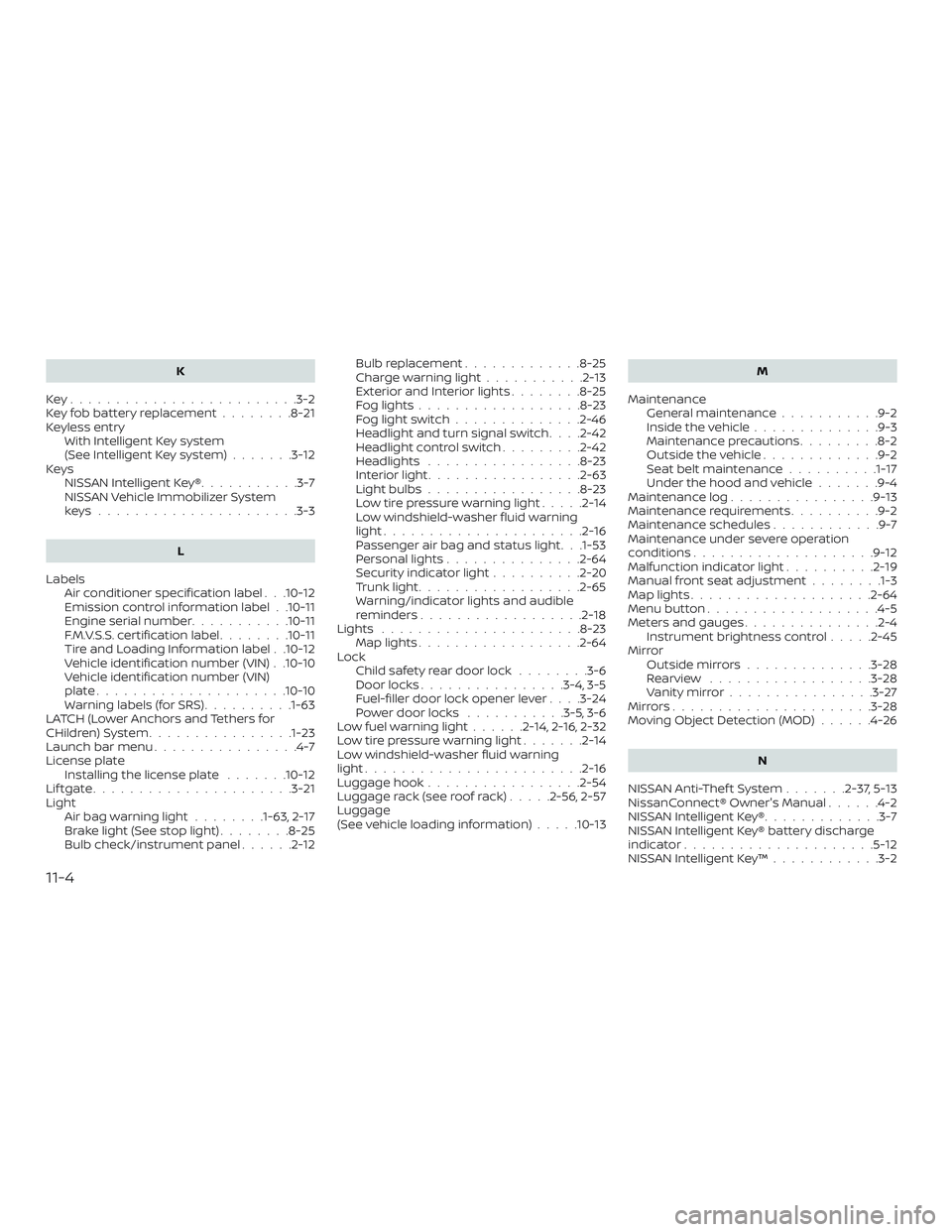
K
Key.........................3-2
Key fob battery replacement ........8-21
Keyless entry With Intelligent Key system
(See Intelligent Key system) .......3-12
Keys NISSAN Intelligent Key® ...........3-7
NISSAN Vehicle Immobilizer System
keys......................3-3
L
Labels Air conditioner specification label . . .10-12
Emission control information label . .10-11
Engine serial number ...........10-11
F.M.V.S.S. certification label ........10-11
Tire and Loading Information label . .10-12
Vehicle identification number (VIN) . .10-10
Vehicle identification number (VIN)
plate.....................10-10
Warning labels (for SRS) ..........1-63
LATCH (Lower Anchors and Tethers for
CHildren)System............... .1-23
Launch bar menu ................4-7
License plate Installing the license plate .......10-12
Liftgate......................3-21
Light Airbagwarninglight........1-63, 2-17
Brakelight(Seestoplight)........8-25
Bulb check/instrument panel ......2-12Bulb replacement
.............8-25
Charge warning light ...........2-13
ExteriorandInteriorlights........8-25
Foglights..................8-23
Foglightswitch..............2-46
Headlight and turn signal switch ....2-42
Headlightcontrolswitch.........2-42
Headlights .................8-23
Interiorlight.................2-63
Lightbulbs.................8-23
Low tire pressure warning light .....2-14
Low windshield-washer fluid warning
light......................2-16
Passenger air bag and status light . . .1-53
Personal lights ...............2-64
Security indicator light ..........2-20
Trunklight..................2-65
Warning/indicator lights and audible
reminders ..................2-18
Lights ......................8-23 Maplights..................2-64
Lock Child safety rear door lock ........3-6
Door locks ................3-4,3-5
Fuel-filler door lock opener lever . . . .3-24
Power door locks ...........3-5, 3-6
Lowfuelwarninglight......2-14,2-16,2-32
Low tire pressure warning light .......2-14
Low windshield-washer fluid warning
light........................2-16
Luggage hook .................2-54
Luggage rack (see roof rack) .....2-56,2-57
Luggage
(See vehicle loading information) .....10-13 M
Maintenance General maintenance ...........9-2
Insidethevehicle..............9-3
Maintenance precautions .........8-2
Outsidethevehicle.............9-2
Seat belt maintenance ..........1-17
Under the hood and vehicle .......9-4
Maintenance log ................9-13
Maintenance requirements ..........9-2
Maintenance schedules ............9-7
Maintenance under severe operation
conditions....................9-12
Malfunctionindicatorlight..........2-19
Manual front seat adjustment ........1-3
Maplights....................2-64
Menu button ...................4-5
Meters and gauges ...............2-4
Instrument brightness control .....2-45
Mirror Outsidemirrors..............3-28
Rearview ..................3-28
Vanitymirror................3-27
Mirrors......................3-28
Moving Object Detection (MOD) ......4-26
N
NISSAN Anti-Thef t System .......
2-37,5-13
NissanConnect® Owner's Manual ......4-2
NISSAN Intelligent Key® .............3-7
NISSAN Intelligent Key® battery discharge
indicator.....................5-12
NISSAN Intelligent Key™ ............3-2
11-4
Page 433 of 444
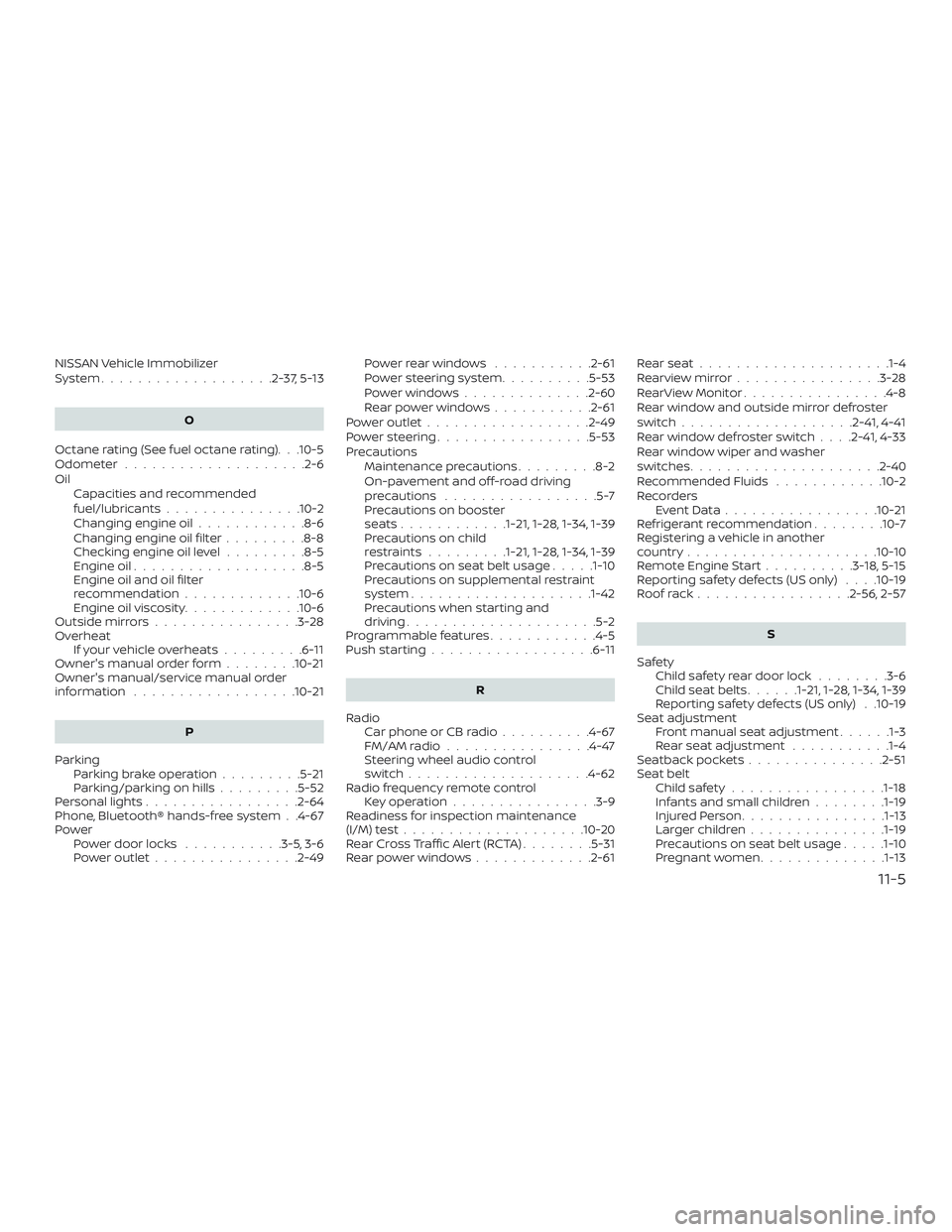
NISSAN Vehicle Immobilizer
System...................2-37,5-13O
Octane rating (See fuel octane rating). . .10-5
Odometer ....................2-6
Oil Capacities and recommended
fuel/lubricants...............10-2
Changing engine oil ............8-6
Changing engine oil filter .........8-8
Checking engine oil level .........8-5
Engine oil ...................8-5
Engine oil and oil filter
recommendation .............10-6
Engine oil viscosity .............10-6
Outsidemirrors................3-28
Overheat Ifyourvehicleoverheats.........6-11
Owner's manual order form ........10-21
Owner's manual/service manual order
information ..................10-21
P
Parking Parking brake operation .........5-21
Parking/parkingonhills.........5-52
Personal lights .................2-64
Phone, Bluetooth® hands-free system . .4-67
Power Power door locks ...........3-5,3-6
Poweroutlet................2-49 Powerrearwindows ...........2-61
Power steering system
..........5-53
Powerwindows..............2-60
Rearpowerwindows...........2-61
Poweroutlet..................2-49
Powersteering.................5-53
Precautions Maintenance precautions .........8-2
On-pavement and off-road driving
precautions .................5-7
Precautions on booster
seats............1-21, 1-28, 1-34, 1-39
Precautions on child
restraints.........1-21, 1-28, 1-34, 1-39
Precautions on seat belt usage .....1-10
Precautions on supplemental restraint
system ................... .1-42
Precautions when starting and
driving.....................5-2
Programmable features ............4-5
Push starting ..................6-11
R
Radio Car phone or CB radio ..........4-67
FM/AMradio................4-47
Steering wheel audio control
switch....................4-62
Radio frequency remote control Key operation ................3-9
Readiness for inspection maintenance
(I/M) test ....................10-20
RearCrossTrafficAlert(RCTA)........5-31
Rearpowerwindows.............2-61 Rearseat.....................1-4
Rearviewmirror................3-28
RearViewMonitor................4-8
Rear window and outside mirror defroster
switch...................2-41,4-41
Rear window defroster switch . . . .2-41, 4-33
Rear window wiper and washer
switches
.....................2-40
Recommended Fluids ............10-2
Recorders EventData.................10-21
Refrigerant recommendation ........10-7
Registering a vehicle in another
country .....................10-10
Remote Engine Start ..........3-18,5-15
Reporting safety defects (US only) . . . .10-19
Roofrack.................2-56,2-57
S
Safety Child safety rear door lock ........3-6
Childseatbelts......1-21, 1-28, 1-34, 1-39
Reporting safety defects (US only) . .10-19
Seat adjustment Front manual seat adjustment ......1-3
Rear seat adjustment ...........1-4
Seatback pockets ...............2-51
Seat belt C
hildsafety................ .1-18
Infants and small children ........1-19
InjuredPerson............... .1-13
Largerchildren.............. .1-19
Precautionsonseatbeltusage.....1-10
Pregnant women ..............1-13
11-5